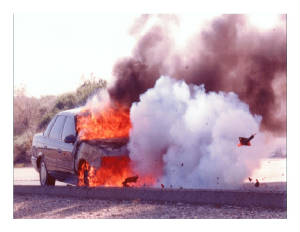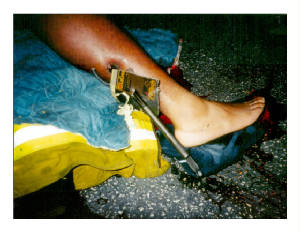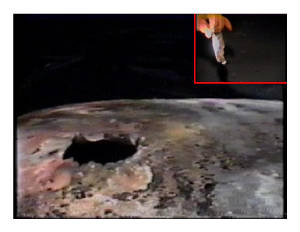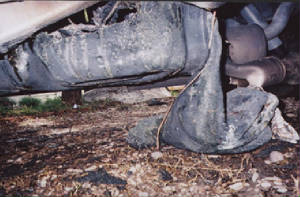|
 |
|
In an effort to absorb impact in low speed crashes,
manufactures began putting nitrogen filled gas struts on their front and rear bumpers in 1973. | |

|
| Click on picture to see - Video |
It didn't take long for the fire service to realize that these
would explode in a vehicle fire. We began training people to approach diagonally to the corner of the vehicle, so as
to be out of the path of one of these should it explode, for years this has been a standard procedure that
is taught nation wide.
Today this is the most dangerous component we face as firefighters.
Not because of its explosive properties, though they still exist and must be taught, but because it is the only danger firefighters
are being taught to avoid.
What is worse, is that 95% of the vehicles on the
road today do not use bumper struts.

|
| Click on the picture to see more |
On Nov. 21, 2004 Drew Hill a Windsor Locks, CT
firefighter was just one of the many, injured by an exploding gas hood strut while fighting a vehicle fire.
The fire was confined to the engine compartment.
Drew was attempting to open the hood, by releasing the hood latch with a halligan bar, when the passenger side hood strut
exploded and fired through his bunker pants, boot and lower leg.

|
| Click on picture to see - Video |
Today we see whole airbag housing exploding and
exiting through the roofs and doors.
In the right hand corner you will notice that;
Further into the investigation, large pieces of shrapnel were found 100 feet behind this vehicle.

|
| Click picture to see more |
Plastic Gas Tanks
Like all plastics, polyurethane melts at very low
temperatures and with these tanks holding from 15 – 28 gallons of gas, a person can only imagine the results if one
dropped its heated load under a burning vehicle.
Yet today we are still teaching firefighters to approach the
vehicle diagonally to the corner, putting them right in the ring of fire, if this were to happen.
Is it time to change our training
Yet?
Many today are still not properly trained in the tactics of
our old attack, and now we have dozens of new dangers, yet with an average of 290,000 car fires reported
per year, they still put their lives on the line.
Click on the link below, and watch where they are walking and standing. This car is a 1976 Buick Regal we
know it had bumper struts. Watch the fire over the right strut.
Vehicle fires at one time were a firefighter’s
fun and games. As you can begin to see, today’s vehicle fires can be some of the most dangerous calls we will respond
to and many changes are going to have to be made, not only in our approach to the vehicle but in the positioning of our apparatus,
our entry into garages, our methods of attack and our absolute necessity for full protective gear.
This web site will take you through;
On the new technologies such as
airbag systems, compressed gas cylinders and plastic fuel tanks as they relate to vehicle fires.

Vehicle Fires and
New Technologies
Power Point and Video Presentations
Car Fires sec# 1
Car Fires sec# 2
Car Fires sec #3a
Car Fires sec#3b
Ford Crown Victoria, Fire Suppression System
Actual Incidents:
Sacramento, CA, Metro Firefighter
Chris Marsh.
“I moved to the passenger side of the vehicle
and started to extinguish the fire through the front grill when all of a sudden, we heard a large explosion,” said Marsh,
explaining about a gas strut exploding under the hood of the vehicle.
The cylinder end of the strut shot out through
the engine compartment and grille and pierced Marsh’s bunker gear and upper leg. The strut was so hot it actually cauterized
his wound as it pasted through. Just missing his femur, it exited through the back of his leg and was found 50 feet down the
road.
NJ. Car fire a few months back...
we were pulling up and had just laid out the line....all of a sudden BOOM. I looked back from where I was at the pump panel
to see air bag fragments fluttering down from the sky. It was quite awe inspiring. I'd say the pieces blew about 25 feet in
the air. I can't remember if they flew up thru a sunroof or the burned out windshield. The fire was in the passenger compartment
of a newer model minivan. It started under the dash and consumed the interior. Tnankfully none of the guys were that close
yet. Best way to handle these fires is a straight stream from a distance til its all darkened down and cooled off.
As for air bags; The industry will claim
they do not react in fires but I have witnessed two steering columns explode during suppression operations. One of
these created a shrapnel hazard when the retaining ring went through the roofs sheet metal.
Ab, Canada: We arrived on scene a few years back to a Volvo sedan on
fire. Pulled past the vehicle about 20 yards off its rear quarter, upwind, and we just stepped off the rig to pull a couple
of lines when, BOOM, the front bumper let loose. After the fire was out we measured the distance the bumper flew. Left side
went 127' the right side 121' it split in half just as it blew.
Return to top of page
Return to --- Midsouth Rescue Technologies
|

